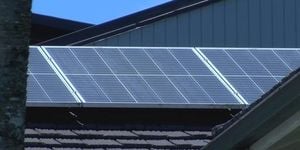Researchers have unveiled the remarkable structural features of the LH1–LH2 co-complex found within the extremophilic purple sulfur bacterium Halorhodospira (Hlr.) halophila strain BN9622. This unique photocomplex possesses a distinct double-ring arrangement, with the larger LH1 ring encapsulating a smaller LH2 ring, which not only provides structural integrity but also maximizes energy transfer efficiency.
The LH1–LH2 co-complex, identified using cryo-electron microscopy (cryo-EM) at 2.22 Å resolution, highlights the functional adaptations of Hlr. halophila to survive and thrive under extreme environmental conditions—as high salinity (over 35%) and alkaline pH (10.7) are found at its natural habitat within hypersaline lakes located in the Libyan Desert. The assembly consists of 18 αβ-subunits within the LH1 and 9 αβ-subunits within the LH2, underlining the complexity of this bacterium's light-harvesting apparatus.
Energy transfer efficiency is key for photosynthetic organisms, particularly for those living under the challenging conditions faced by extremophiles. The study indicated almost 100% efficiency of exciton transfer from LH2 to LH1, as the closely packed structure allows for optimal interactions between pigment molecules. "Energy absorbed by LH2 and transferred to LH1 allows for competitive advantages under extreme environmental conditions," the authors noted.
This remarkable capability likely evolved to allow Hlr. halophila to maximize light usage, optimizing its photosynthetic process even when resources are scarce. The co-complex features interconnections between the two layers of bacteriochlorophyll (BChl) molecules, enabling rapid excitonic interactions. The structural arrangement of pigments plays not only a role in light capture but also is believed to influence how energy is efficiently channeled to the reaction center for photosynthesis.
The study not only advances our knowledge of the structural biology of purple phototrophic bacteria but also emphasizes the evolutionary adaptations these organisms have undergone to survive under extreme conditions. Understanding these mechanisms deepens our comprehension of photosynthesis itself and may hold applications for biotechnological innovations.
With extensive insights gained from studying the LH1–LH2 co-complex, researchers now aim to explore additional evolutionary adaptations and applications using these extremophiles for various scientific and industrial purposes. The structural features presented here, particularly the efficiency of energy transfer pathways, open avenues for future exploration of how we can mimic or utilize these processes for human benefit.
Further research is required to answer intriguing questions about energy transfer mechanisms and their potential applications, particularly concerning how closely stacked complexes, like those seen with Hlr. halophila, facilitate improved energy harvesting under less-than-ideal conditions.



